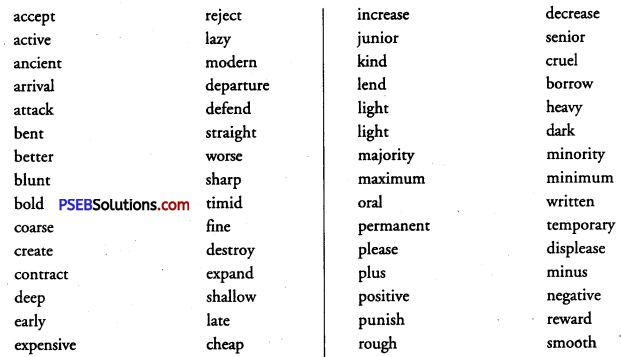Punjab State Board PSEB 9th Class English Book Solutions English Vocabulary Formation of Words Exercise Questions and Answers, Notes.
PSEB 9th Class English Vocabulary Formation of Words
A. Compound Words
किन्हीं दो या दो से अधिक शब्दों के मेल से बने नये शब्द को Compound word कहते हैं; जैसे book + shop = bookshop grand + father = grandfather कुछ Compound words किन्हीं दो या दो से अधिक शब्दों में योजक चिन्ह (-) लगाकर जोड़ने से भी ; the Sister-in-law; ready-to-serve; air-conditioned.

Match the words in column A with the words in column B to make Compound words :
A —- B
basket —- wife
grand —- life
sun —- yard
milk —- ball
houses —- book
vine —- post
lamp —- glasses
wild —- maid
over —- worked
world —- father
text —- grocer
green —- wide
Answer:
basketball; grandfather; sunglasses; milkmaid; housewife; vineyard; lamp post; wildlife; overworked; worldwide; textbook; greengrocer.
Rewrite the word by inserting a hyphen (-), if required :
fiftynine — headache
easygoing — welloiled
preschool — uptodate
mothertobe — selfstudy
busybody — inlaws
highway — incometax
snowbound — waterbased
snowstorm — household
Answer:
fifty-nine; easy-going; pre-school; mother-to-be, busybody; highway; snowbound; snowstorm; headache; well-oiled; up-to-date; self-study, in-laws; income tax; water-based; household.

Choose suitable compound words from the given list to complete the sentences :
world-famous ; oil-based ; handmade ; bulletproof ; air-conditioned ; absent-minded ; eyesight ; downtown.
1. In summer, many people like to travel by ……………. buses.
2. Vikram Seth is a ……………. writer.
3. Chaman Lal got his house painted with ………….. paints.
4. Where did you buy this ……………. paper ?
5. He goes ……………. every week to buy his grocery.
6. Get your ……………. checked; I think you need glasses.
7. The policeman was saved because he was wearing a …………… jacket.
8. My father is becoming ……………; he never pays his bills on time these days.
Answer:
1. air-conditioned
2. world-famous
3. oil-based
4. handmade
5. downtown
6. eyesight
7. bulletproof
8. absent-minded.
Formation Of Words
शब्दों को उनके प्रयोग और रूप के अनुसार भिन्न-भिन्न वर्गों में बांटा जा सकता है; जैसे
1. Noun
2. Adjective
3. Verb
4. Adverb
अनेक शब्द ऐसे होते हैं जिनके एक रूप को हम दूसरे रूप में बदल सकते हैं; जैसे

राब्द के एक रूप को दूसरे रूप में बदलने (अर्थात् शब्द-रचना करने) का कोई विशेष नियम नहीं होता है। अपने शब्द-ज्ञान को बढ़ाने के लिए हमें शब्दों के विभिन्न रूपों को कण्ठस्थ ही करना पड़ता है।
B. Prefixes & Suffixes
Prefix (उपसर्ग) उस शब्दांश को कहा जाता है जिसे किसी शब्द के आरम्भ में जोड़ने से एक नया शब्द बन जाता है। Prefix का अपना कोई अर्थ नहीं होता, किन्तु वह दूसरे शब्द से जुड़ कर उसके अर्थ में परिवर्तन कर देता है; जैसे happy के आरम्भ में un उपसर्ग लगाने से एक नया शब्द unhappy बन जाता है। take के आरम्भ में mis उपसर्ग लगाने से एक नया शब्द mistake बन जाता है।
Suffix (प्रत्यय) उस शब्दांश को कहा जाता है जिसे किसी शब्द के अन्त में जोड़ने से एक नया शब्द बन जाता है।
Suffix का अपना कोई अर्थ नहीं होता है, किन्तु वह दूसरे शब्द में जुड़ कर उसके अर्थ में परिवर्तन कर देता है; जैसे
king के अन्त में dom प्रत्यय लगाने से एक नया शब्द kingdom बन जाता है।
quarrel के अन्त में some प्रत्यय लगाने से एक नया शब्द quarrelsome बन जाता है।

Complete the sentences using the correct form of the words given in the brackets :
1. There were a lot of games for …………… at my cousin’s party. (amuse)
2. After the ………….. of the bridge, the labourers will be sent to some other place. (complete)
3. She is learning French in …………… to English and Punjabi. (add)
4. He was asked to show his passport for ………… . (verify)
5. Due to the ………….., the wall of the house collapsed. (seep)
6. I am going to write a letter to the …………….. of that newspaper. (edit)
7. Many children receive awards for their …………… on Republic Day every year. (brave)
8. ………… classes are held in Adarsh Colony to train the needy women. (sew)
9. Some people kill animals and birds for …..
10. The main …………….. of some tribals in Rajasthan is camel breeding. (occupy)
Answer:
1. amusement
2. completion
3. addition
4. verification
5. seepage
6. editor
7. bravery
8. Sewing
9. pleasure
10. occupation.
Match the Verbs under column A with their Nouns under column B :
A —- B
vibrate —- burial
permit —- preference
prosper —- actor
prefer—- permission
act —- settlement
employ —- relation
relate —- vibration
settle —- authority
bury —- employee
authorize —- prosperity
Answer:
vibrate—vibration; permit—permission; prosper—prosperity; prefer—preference; act—actor; employ—employee; relate—relation; settle—settlement; bury—burial; authorize—authority.

Form Nouns from the following Verbs and use them in sentences of your own :
preach, create, appear, arrive, enjoy, apologize, develop, meet, deliver, memorize.
Answer
1. Preacher — Satguru Ram Singh Ji was a great preacher.
2. Creation — The cake was a delicious creation of sponge, cream and fruit.
3. Appearance — Appearances are often deceptive.
4. Arrival — Are you sure about the late arrival of the train ?
5. Enjoyment — Gardening is one of my chief enjoyments.
6. Apology — I owe you an apology.
7. Development — He bought the land for development.
8. Meeting — What was decided at Friday meeting ?
9. Delivery — Your order is ready for delivery.
10. Memory — He has a good memory for dates.
Fill in the correct words in the blanks with the help of words given in the brackets :
1. We will …………… our house by growing flowering plants. (beauty)
2. Don’t …………… your life by going near the fire. (danger)
3. In a few years, the government is likely to …………….. several villages. (electricity)
4. She couldn’t …………… her stay abroad for so many months. (justice)
5. You can’t ………….. me with your lies any more. (fool)
6. My friends ………….. playing in the sun even in the summer. (joy)
7. Can you ……………. the bad points of smoking ? (list)
8. I won’t ……………. you by talking again about that accident. (terror)
Answer:
1. beautify
2. endanger
3. electrify
4. justify
5. befool
6. enjoy
7. enlist
8. terrify.
Match the Nouns in column A with the Adjectives from column B :
Α —- B
expense — yearly
year — intelligent
economy — defensive
edit — exemplary
flower — needful
example — floral
defence — editorial
intelligence — economical
need — expensive
Answer:
expense — expensive; year — yearly; economy — economical; edit — editorial; flower — floral; example — exemplary; defence — defensive; intelligence — intelligent; need — needful.

Use a prefix / suffix with the words given in the brackets. Make necessary changes in the words, if required :
1. There are many …………… hotels in Mumbai. (luxury)
2. A ………….. function was held on the eve of Diwali. (colour)
3. Is it ………….. to travel by. air ? (economy)
4. The stay in Singapore was very …………….. (expense)
5. Sunil acts quite …………….. at times. (child)
6. The discussion took place in a …………….. atmosphere. (friend)
7. I am going to make my ……………. trip to Varanasi in June. (year)
8. It turned very …………….. in the evening. (dust)
9. The money will be given to some …………….. persons. (need)
10. Abdul is a very …………. person; he works 14 hours a day. (industry)
Answer:
1. luxurious
2. colourful
3. economical
4. expensive
5. childishly
6. friendly
7. yearly
8. dusty
9. needy
10. industrious.
Form Adjectives from the following Nouns :
accident; adventure; abuse; east; fault; hand; guilt; might; difference; example
Answer:
accident – accidental; adventure – adventurous; abuse – abusive; east – eastern; fault – faulty; hand – handy; guilt – guilty; might – mighty; difference – different; example – exemplary.
Form Nouns by adding the suffixes -ity, -th, -dom, -ness, -ence to the words given in the brackets :
1. Many areas of Bihar are known for their …………….. (backward)
2. I felt very uncomfortable in Chennai because of the (humid)
3. “What’s the …………… of your turban ?” the foreigner asked. (long)
4. Because of her ……………. she could not go there. (ill)
5. Nelson Mandela went to jail for the ……………. of his people. (free)
6. Is there any …………….. of the train coming late ? (possible)
7. There is ………….. in her behaviour. (warm)
8. Ramanand Jewellers are known for the …………….. of their gold. (pure)
9. No one spoke in the …………….. of the police. (present)
10. His ………….. was felt by all. (absent)
Answer:
1. backwardness
2. humidity
3. length
4. illness
5. freedom
6. possibility.
7. warmth
8. purity
9. presence
10. absence.

Form Verbs from the following Adjectives :
able, broad, black, deep, false, popularsad, sick, glorious, minimum, deep
Answer:
able — enable; broad — broaden; black — blacken; deep — deepen; false — falsify; popular — popularize; sad — sadden; sick — sicken; glorious — glorify; minimum — minimize.
Add suffixes / prefixes to the words given in the brackets and write them in the space provided :
1. Go to the Rose Garden. The roses will …………….. (glad) you.
2. You can …………… (rich) your knowledge by reading good books.
3. Some children cannot ……………. (different) between p and b.
4. I think the mystery will further …………….. (deep) in the novel I am reading.
5. Buy a cycle; it will …………. (able) you to reach your school in time.
6. I am trying to ….. (minimum) my expenses.
7. The computer will …………… (right) the error if you give it the correct command.
8. Sukhbir will like to …………….. (special) in medicine.
Answer:
1. gladden
2. enrich
3. differentiate
4. deepen
5. enable
6. minimize
7. rectify
8. specialize.
Match the Verbs in column A with the Adjectives in Column B :
A — B
agree — admirable
admire — selective
select — collective
doubt — helpful
collect — removable
change — agreeable
remove — changeable
help — doubtful
Answer:
agree – agreeable; admire – admirable; select – selective; doubt – doubtful; collect – collective; change – changeable; remove – removable; help – helpful.

Form Adverbs from the following Adjectives and use them in sentences of your own :
brief, broad, bitte, calm, easy, frequent, generous occasional, peaceful
Answer:
1. Briefly—Answer these questions briefly.
2. Broadly — Broadly speaking, I agree with you.
3. Bitterly — He was talking bitterly to his wife.
4. Calmly — He listened to my whole problem calmly.
5. Easily — I could solve all the questions easily.
6. Frequently — Buses run frequently from the station to the airport.
7. Generously — He helps the poor generously.
8. Occasionally — He comes here only occasionally.
9. Peacefully — Men should learn to live peacefully with each other.
Match the words in column A with their Abstract Nouns in column B :
A — B
beggar — brotherliness
brother — earldom
chemist — membership
earl — begging
friend — inspection
inspector — patriotism
member — friendship
patron — chemistry
patriot — widowhood
widow — patronage
Answer:
beggar — begging; brother—brotherliness; chemist — chemistry; earl — earldom; friend — friendship; inspector — inspection; member — membership; patron — patronage; patriot — patriotism; widow — widowhood.
Form Abstract Nouns from the following words and use them in sentences of your own :
act, agent, child, infant, mother, hero, partner, recruit, move
Answer:
1. Action – What is your next plan of action ?
2. Agency – There is an advertisement agency near our house.
3. Childhood – We spent our childhood in great joy.
4. Infancy – Many poor children die in their infancy.
5. Motherhood – There is no joy like the joy of motherhood.
6. Heroism – Our soldiers showed great heroism during the war.
7. Partnership – I have a partnership in this firm.
8. Recruitment -The recruitment of new workers will take place next month.
9. Movement – The movement of goods from one place to the other is a big problem.
Write the opposite of the statements given below. Use the prefixes ir-, un-, in-, im-, il-, diswith the italicized words :
1. Mr. Reddy is known for making logical statements.
2. The speaker made several relevant points in his speech.
3. The fire-fighters were able to rescue the child trapped inside the house.
4. Savita is a very mature person.
5. Is it legal to have two wives ?
6. Some students are regular in attending classes.
7. Your handwriting is quite legible.
8. My father likes boys who have long hair.
9. Quite a lot of people are literate in any colony.
10. The foreigners were very polite to me.
Answer:
1. Mr. Reddy is known for making illogical statements.
2. The’ speaker made several irrelevant points in his speech.
3. The fire-fighters were unable to rescue the child trapped inside the house.
4. Savita is a very immature person.
5. Is it illegal to have two wives?
6. Some students are irregular in attending classes.
7. Your handwriting is quite illegible.
8. My father dislikes boys who have long hair.
9. Quite a lot of people are illiterate in any colony.
10. The foreigners were very impolite to me.

Use fore-, pre-, mono-, anti-, post-, out-, ex-, under- with the words given in the brackets and use them to complete the sentences :
1. It is proved that our …………….. (father) were monkeys.
2. To avoid illness, take ………………. (malaria) tablets in the rainy season.
3. Soon ………………. (rail) will be introduced in many big, crowded cities in India.
4. Mrs. Kapoor is so ……………. (spoken) that a few people like to talk to her.
5. The …………….. (independence) progress is quite remarkable in our country.
6. The …………….. (headmaster) of our school was the Chief Guest at the Annual Function.
7. The pilot was …………….. (warned) about the bad weather. ………….. (age) children are not allowed to see the A movies in cinema halls.
9. My three-year-old nephew is studying in a ………… …… (nursery) class.
10. ……………… (aircraft) guns are commonly used in wars.
Answer:
1. forefathers
2. anti-malaria
3. mono-rail
4. outspoken
5. post-independence
6. ex-headmaster
7. fore-warned
8. Underage
9. pre-nursery
10. Anti-aircraft.
Formation of Word By The Use Of Phefixes & Suffixes
(i) Forming Nouns From Verb :
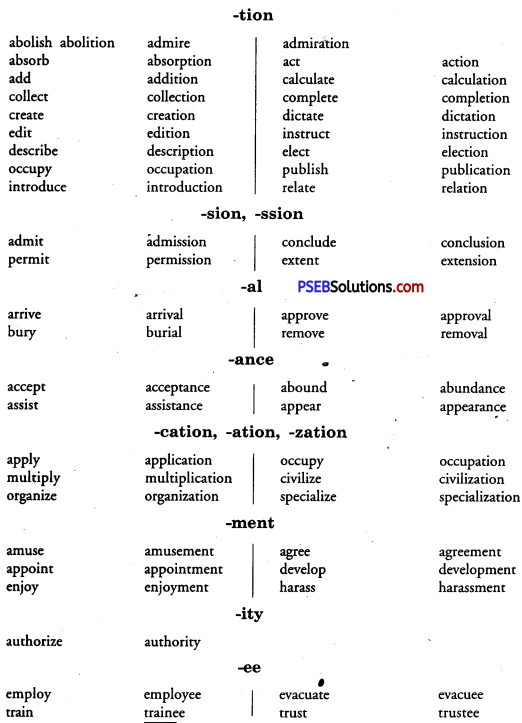
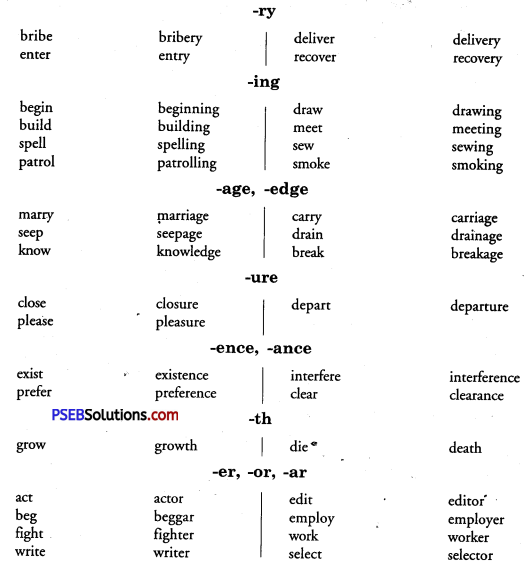
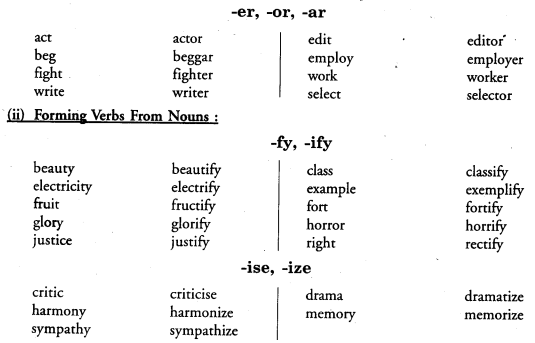
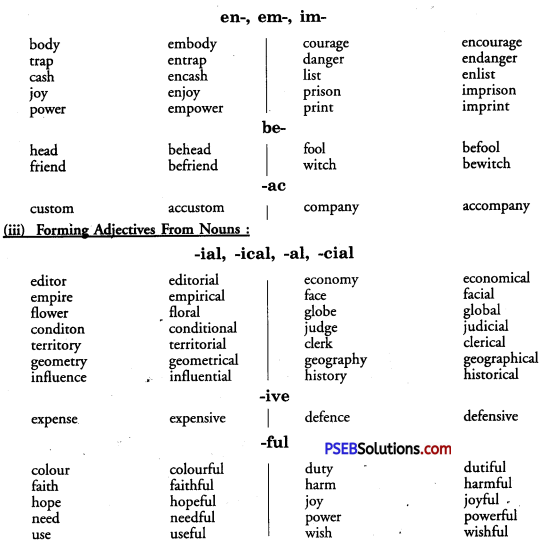
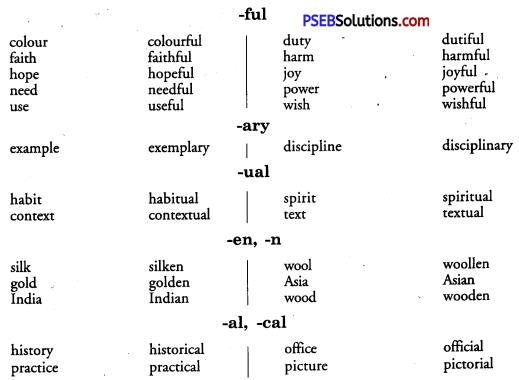
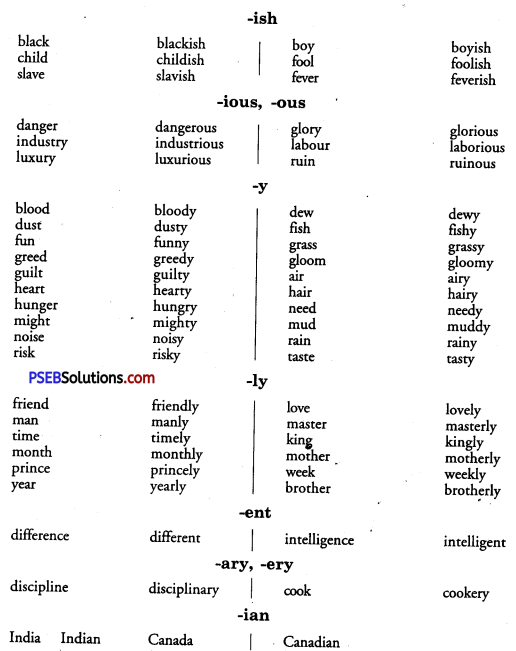

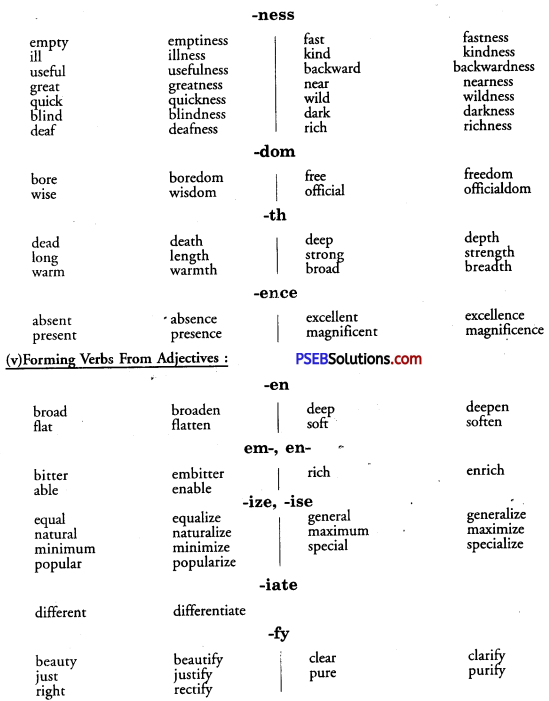

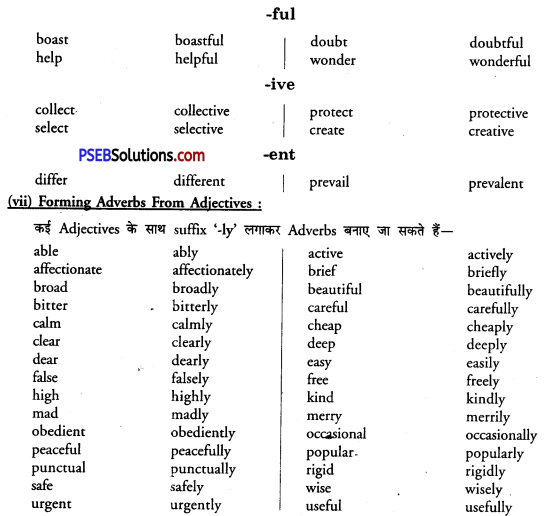
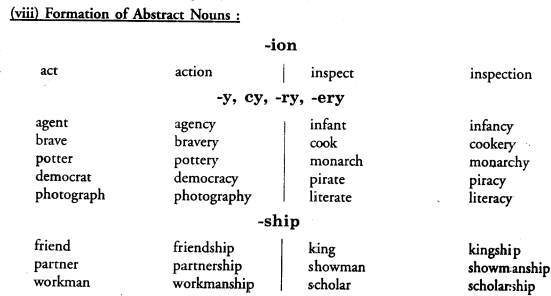
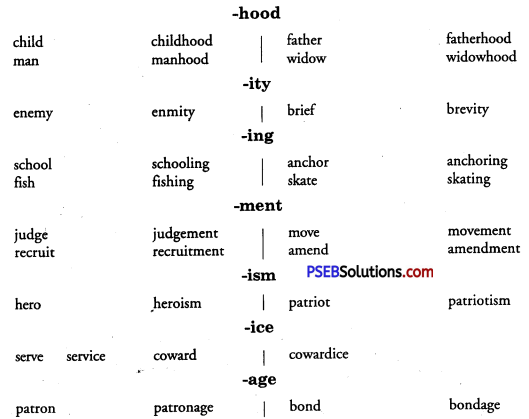
(ix) Negative Prefixes:
in – : inactive, incomplete, inanimate, inhuman
dis – : disappear, dislike, disrespect
un – : unable, unkind, untie
im – : impossible. impolite, immature
ir – : irregular, irresponsible, irrelevant
il – : illegal, illegible, illiterate
mis – : misplaced, misfortune, mislead
mal – : malfunction, maladjustment, malpractice

(x) Prefixes That Denote Degree :
extra – : extracurricular, extraordinary
mini – : mini-skirt, mini-track
out – : outshine, outspoken, outshoot
over – : overdose, overdraw, overage
semi – : semi-darkness, semi-commercial, semi-liquid
sub – : sub-region, sub-depot,
super – : supernatural, superman
under – : underage, underhand, undergraduate
(xi) Prefixes That Express Time of Sequence:
ex -: ex-principal, ex-inspector
fore – : forewarn, forecast, forefather
post – : post-independence, post-haste
pre – : preoccupy, pre-eminent
re – : recast, remarry recall
(xii) Prefixes That Express Number:
bi – : bicycle, hi-yearly
mono – : mono-drama, mono-type, mono-rail
tri -: tripod, tri-partition, tricycle

(xiii) Prefixes That Express Attitude:
anti – : antiseptic, anti-tank
co – : co-accused, co-education
counter – : counrâpan, counterbalance
pro – : pro-establishment
![]()













